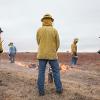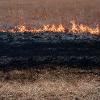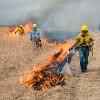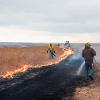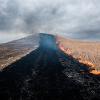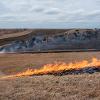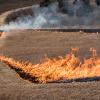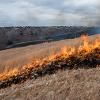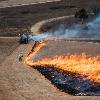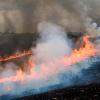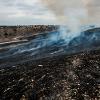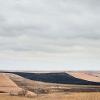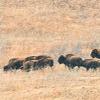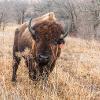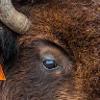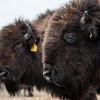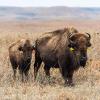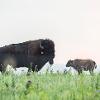Home of the Range: Konza Prairie Biological Station works to conserve one of the most diminished ecosystems in North America
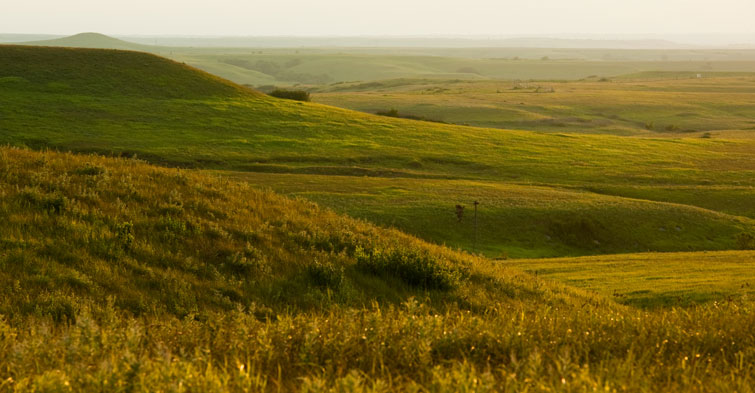
By Stephanie Jacques
American bison graze on grass that can grow taller than most people, rainbows of wildflowers dance in the breeze on the limestone-studded terrain, and new life rejuvenates the charcoaled hills in spring. This mosaic landscape is the Kansas Flint Hills, home to the nation’s most diminished ecosystem.
The tallgrass prairie today is about 4 to 5 percent of its original glory. Most of its former range — from Canada to Texas and from Kansas east to Indiana — is now cropland, urban development or woodland. The largest remaining expanse of native prairie is in the Flint Hills of Kansas and Oklahoma because the rocky land made it difficult for settlers to plow.
“We all like to eat, and we eat a lot of food, so those former grasslands are important for our cropland,” said John Briggs, director of Konza Prairie Biological Station, an 8,600-acre native tallgrass prairie research station on the northern edge of the remaining tract of Kansas prairie. “On the other hand, the intact tallgrass prairie here is some of the most productive grassland in the world and supports the multibillion-dollar cattle industry in Kansas.”
Researchers at Konza Prairie, jointly owned by Kansas State University and The Nature Conservancy, have been fostering long-term ecological research, education and prairie conservation for more than 45 years. Konza’s decades of data give ecologists and land managers an understanding of multiple influences on the rich ecosystem and provide an indication of how the prairie ecosystem works in a controlled environment with minimal human influence.
“Konza is an important reference site and is very unique in that the longterm research gives us the opportunity to see changes over many years,” said Brian Obermeyer, Kansas landscape programs manager for The Nature Conservancy. “A lot of things you can’t tease out in a two- or three-year study. It takes a long time to really understand how the prairie ticks and it may take decades to get conclusive data.”
Konza Prairie’s ecological research is as diverse and extensive as the prairie itself, with more than 150 active research programs collaborating and coinciding on the landscape. Managed by Kansas State University’s Division of Biology, the site has produced historical data on climate and rainfall patterns; cattle and bison effects on prairie diversity; the value of prairie fires to control threatening tree invasions; plant, insect, bird and mammal populations; nitrogen cycling; soil carbon; and the quality and quantity of tallgrass-filtered water.
“Konza’s research and the advancement of ecological theory can help people understand why we need grasslands, the danger of losing them and techniques to conserve and even restore them,” said Briggs, who also is a professor of biology.
Blazing and grazing a path
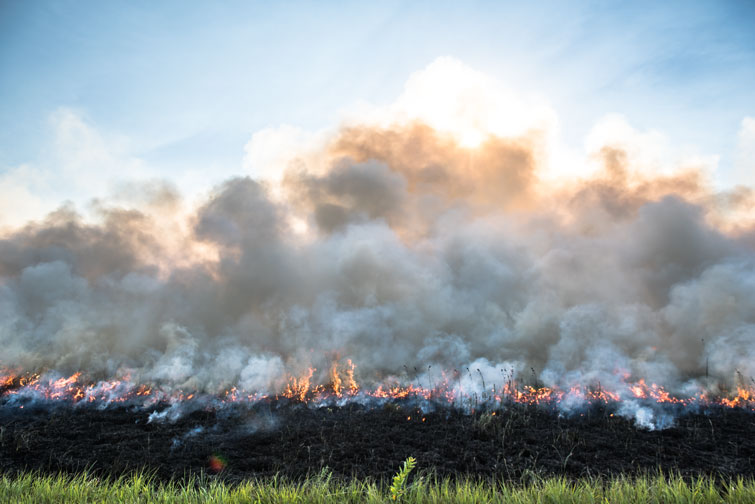
Konza Prairie — where dry grass is intentionally set on fire — is home to a herd of 250 to 300 American bison and 215 cow/calf pairs of cattle. Konza data demonstrate that both fire and grazing are important to tallgrass prairie management and influence prairie ecology. Konza is divided into more than 50 research units called watersheds, each with a different experimental approach.
Each watershed has an assigned burning season — winter, fall, summer or the traditional spring burning — and a fire frequency in one-year, two-year, four-year or 20-year burning regimens in grazed and ungrazed prairie watersheds.
“The key to effectively managing the prairie is the interaction of fire and grazing — not just one versus the other,” said Tony Joern, university distinguished professor of biology who studies grassland ecology and the interaction of insect and plant communities.
Some of Konza’s watersheds host bison as a historical reference for how native grazers influence prairie ecology. Other watersheds host cattle, the most common grazer of today’s prairie. Ungrazed watersheds provide comparisons to both grazers and mimic conditions at many prairie preserves in the region.
“If land managers put any kind of grazer — cattle, bison or even mowing — in an annual burned site, it increases plant diversity because cattle and bison eat the dominant grasses, which allows the subdominant plants called forbs, or flowering plants, to increase,” Briggs said.
If not controlled by grazing, the towering tallgrass — like big bluestem, the iconic grass of the tallgrass prairie that can reach heights of 6 to 8 feet with a root system nearly twice that size — can overshadow the flowering plants and reduce plant diversity.
“Fire and grazing work together to open up the canopy and expose short wildflowers to key resources, which increases plant diversity,” Joern said. “The more plant species you have on a prairie, then the more animal diversity there will be, including more pollinators. Ecological diversity starts with plants, which affect diversity at all levels.”
A nearly 20-year collection of grasshoppers on ungrazed prairie compared with a 10-year collection of grasshoppers on grazed prairie indicated that moderately grazed watersheds have 32 percent more arthropods, with some areas reaching as much as 50 percent more insects. According to Joern, the increase in insects will increase the animals that prey on them.
Beyond favoring the tallgrasses, fire also controls the invasion and expansion of trees and shrubs, called woody encroachment, Briggs said. On Konza, there is a visual contrast between annual burned watersheds and 20-year burned watersheds, which have more trees and shrubs but less grasses and forbs.
“If you leave the prairie unburned for more than eight to 10 years, you start getting a decrease in plant diversity — especially in prairie plants — as a few dominant woody plants, such as cedars, dogwoods and sumac, will take over,” Briggs said.
The encroachment of woody vegetation caused by a lack of fire threatens the remaining areas of tallgrass prairie ecosystem. According to Briggs, increased tree cover not only changes the appearance of traditional prairie but also devastates wildlife habitat for grassland animals like greater prairie chickens.
“The grassland is a nursery,” Briggs said. “That’s where the young birds are born and are raised. If they have restricted grassland sites, you are not going to get the birds reproducing at the rates they used to and this is a cause for concern.”
Researchers further defined the relationship between fire and grazers for prairie health by using tracking collars on the bison. The records indicate that the bison follow fire to the watersheds with the newest and most nutritious grass.
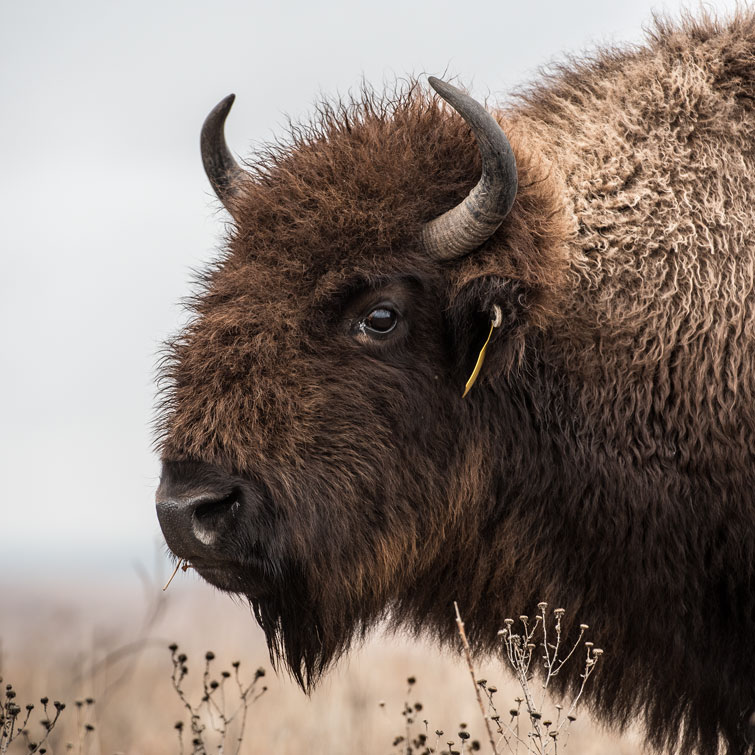
“Bison and cattle are attracted to areas that have been recently burned,” Joern said. “If you have an area that has had very little grazing and then you burn it, the grazers basically spend the summer there. The areas that they grazed the summer before are left mostly untouched and build up fuel for the next burn.”
Joern said that the fire-grazing interaction moves around in time and space on the prairie to create a cycle. The consequences of that cycle are effectively measured only over many years.
“Konza shows that long-term research is essential,” Joern said. “Historically, researchers thought burning every four years would keep woody vegetation under control. Based on the accumulation of data of Konza’s watersheds, we are seeing that’s probably no longer the case. We’re thinking burning at least every three years is the most effective to managing that cycle.”
According to John Blair, director of Konza Prairie’s Long- Term Ecological Research program, which is funded by the National Science Foundation, long-term studies are needed to understand the prairie’s responses to reduced fire frequencies.
“Sometimes the prairie responds abruptly to environmental changes, indicating that the prairie may have thresholds of stability where it is resilient to change until it is pushed beyond a tipping point,” Blair said. “That appears to be the case when we look at the prairie’s responses to reduced fire frequencies.”
Blair said that the changes to the prairie from a lack of fire are slow at first, but once woody plants have established, the conversion from a grass-dominated prairie to a shrubland or woodland can occur quickly. The change is rapid because the trees and shrubs reduce grass. Less grass reduces the fuel that makes the rejuvenating prairie fire possible. This makes it very difficult to restore the grassland to its original state. The researchers have seen this in a few heavily wooded watersheds that used to be burned every 20 years and have recently been changed to annual burned watersheds.
“It can take decades to see these types of threshold changes,” Blair said. “The real value of our long-term studies is being able to run experiments long enough to separate short-term responses from longer-term responses that may only start to reveal themselves after a decade or more of running the experiment.”
Profit and prairie health
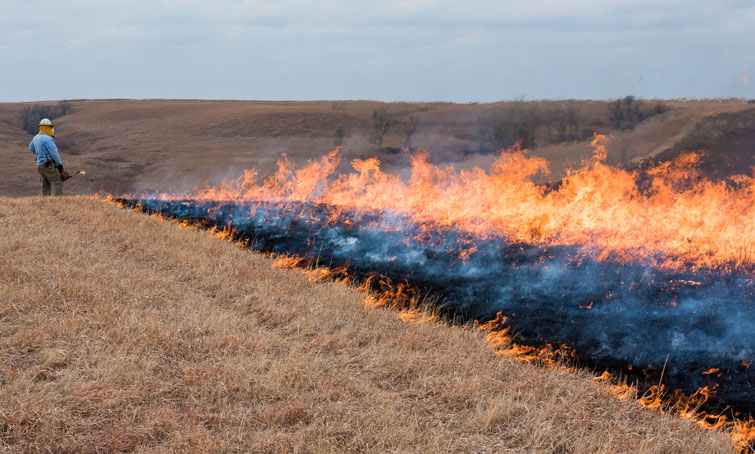
Konza Prairie’s patch burn study is a long-term study to determine how burning a third of the prairie every year will affect the ecological performance and cattle performance, such as weight gain and fertility. Two patch burn watersheds were established, each divided into three sections, with one section burned each year. Cattle have free roam of the entire space.
According to Kansas Department of Agriculture economists, animal agriculture is responsible for $21.9 billion in direct revenue, which supports 67,832 jobs in Kansas. Flint Hills-grazed cattle, a part of that revenue, depend on regularly burned tallgrass prairie, according to KC Olson, professor of animal sciences and industry who is collaborating with Joern for the study.
“Fire is absolutely essential to rangeland health, over the long and the short term,” Olson said. “It’s a major determinate in livestock performance. If we exclude fire over the long term, we get an undesirable composition change, which influences livestock performance in a negative way.”
Olson said that an average of about 30 pounds of gain or growth per animal is missed if cattle graze on prairie that hasn’t been burned that year. Less growth means cattle production decreases, an economic hit to ranchers. In contrast, research from Konza’s annually burned watersheds suggests that burning every year can decrease plant diversity. Therefore, the patch burn study gives sections of prairie a chance to rest from fire while also allowing cattle access to a newly burned section.
“In the patch burn systems, the predictability of cattle movement is incredible,” Olson said. “In a normal moisture year, cattle spend about 75 to 85 percent of their time on the patch that has been burned that particular year.”
The amount of time cattle spend on the burned section is why Olson’s yearly cattle productivity measurements, since 2010, have not shown performance differences between cattle in the patch burned areas versus the annually burned controls. Olson has noticed one difference between the two areas.
“In 2011, 2012 and 2013, when drought conditions were pretty severe and we destocked our annually burned pastures, we didn’t have to do anything in the patch burn pastures,” Olson said. “There was a significant amount of residual forage in the unburned areas that was sort of drought insurance that we did not have in the annual burn pastures.”
Coinciding with the cattle performance research on the patch burn watersheds, Walter Dodds, university distinguished professor of biology, is collecting water samples from Kings Creek, Konza’s water source, which is a U.S. Geological Survey benchmark site because about two-thirds of its headwaters are confined to Konza’s unpolluted conditions. He is using Konza’s more than 25 years of water quality and discharge data to compare the effects of the cattle and bison as well as how water quality on Konza compares to the rest of the tallgrass prairie.
“We are seeing more of an effect on water quality with the cattle than the bison, mostly with increased levels of ammonia,” Dodds said. “But one of the things that we’ve found is that current cattle grazing practices across the Flint Hills have conserved this endangered ecosystem and preserved good water quality relative to areas with cropland.”
Prairie beauty only soil deep
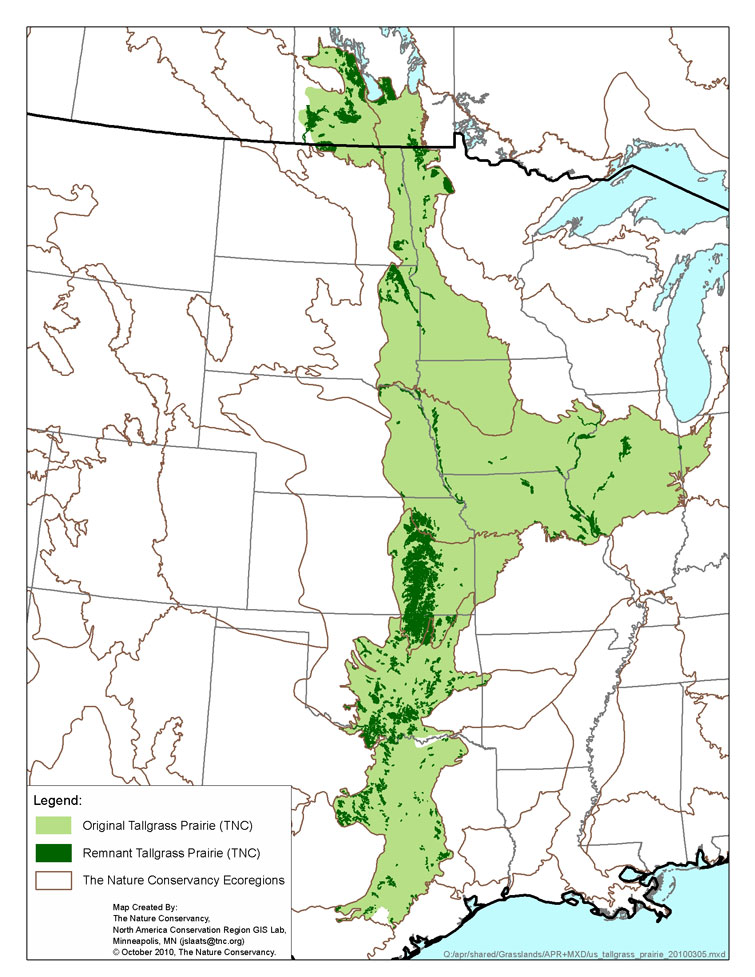
The vast majority of Konza Prairie serves as a reference site for other tallgrass prairie areas because it has never been plowed. But researchers have found a use for the few areas along Konza’s entrance and headquarters that have been plowed: They offer an opportunity for researchers to attempt to re-create prairie.
“Farmers are able to convert the nutrients that have been stored in grassland soil over hundreds of thousands of years to crops that feed us,” Briggs said. “It’s good soil for growth, but as the need to feed more people increases and grasslands are consumed by nonnative plants, it’s getting to be more and more of a conservation challenge to maintain the tallgrass prairie.”
Briggs said that the U.S. Department of Agriculture’s Conservation Reserve Program, which provides financial incentives for farmers to convert less productive cropland back to prairie for 10-15 years, has helped conservation efforts, but the ecosystem may not return to its belowground unplowed condition for 100 years.
“To the casual observer, a restored prairie looks pretty but if you really dive into the details, the diversity is missing, especially in the soil,” Briggs said. “You get a lot of really tall grasses that dominate the prairie like a 300-hundred-pound gorilla to keep everything out of the field. There are a lot of plants missing, especially the flowering and non-grasses — the ones that provide all of the coloring in the springtime.”
Konza researchers are involved in multiple projects that evaluate the ecological and human factors that affect prairie restoration success, such as manipulating soil resources by adding rocks under the soil to mimic the hilly terrain of the Flint Hills or adding sawdust and table sugar as sources of carbon to increase soil microbe populations and reduce nitrogen availability.
A few of the projects measure changes in restored prairies over time as part of Konza’s Long Term Ecological Research program, one of the NSF’s original six funded long-term programs in the nation.
According to Blair, a common problem in prairie restoration is that even if a variety of plants is planted initially, diversity decreases over time. Blair and his colleagues started the first prairie restoration study, called the environmental heterogeneity hypothesis project, on Konza in 1998. It is based on a theory that increasing heterogeneity of soil resources will help increase plant diversity in restored prairie.
“It builds on the data collected from Konza that suggests that soil nitrogen availability and soil depth, or water availability, are some of the key factors that influence diversity in native grasslands,” Blair said. “We want to know if we can use this information to steer recovery of prairie.”
Another project is an ongoing sequential restoration experiment. Over 20 years, researchers will restore 65 square feet of cropland every two years with the same species of seed mixture and timing and planting techniques to see how the prairie restoration is affected by variations in climate and precipitation.
“We have some sections that started in a really good spring and all the plants germinated and took off, and others that we started in really weedy conditions, and others that started in drought conditions,” Blair said. “We want to understand, over time, if the deterministic management factors take over.”
In chronosequence and restoration benchmark studies, researchers are using the soil from intact prairie as a reference for cropland off Konza that was converted in the early 1980s. This helps researchers like Blair understand how time affects the prairie restoration.
“The data collected from native prairie across the Konza landscape provides basic benchmarks that other prairie restoration projects in the Flint Hills can aim for to reach the prairie’s full potential,” Blair said.
The restoration projects are just a few of Konza’s programs and projects that are designed to help further ecological theory and improve grassland management in the tallgrass prairie ecosystem and around the globe. Briggs said educating the next generation is important to obtaining that goal.
“Education is a major component of Konza’s mission, particularly since we are a research university,” Briggs said. “Training and hands-on experiences for undergraduates and graduate students are essential for the future. We have taken on the additional task of education from K-12 to the general public, and we hope that all of these aspects lead to appreciation and understanding of tallgrass prairie to assure that this endangered ecosystem is protected.”
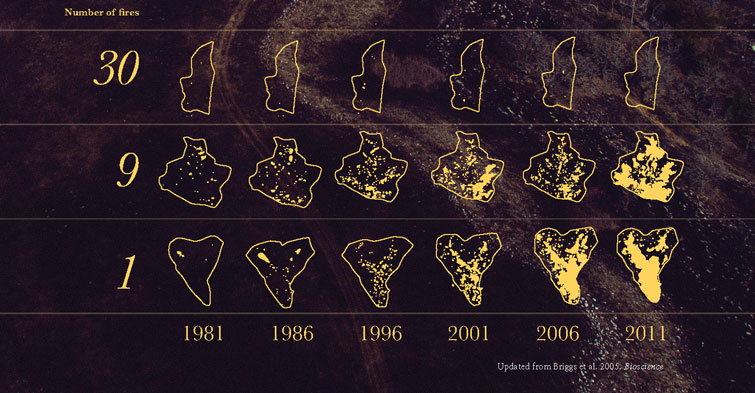 |
Counting shrubs for 30 years in annually burned, four-year burned and 20-year burned watershedsResearchers at Konza have hard numbers that show that the tallgrass prairie has a tipping point in the absence of fire. Konza Prairie’s research units — called watersheds because their boundaries are set by how the rainfall and water flows down them — are burned at different frequencies. In the annually burned watersheds, the amount of shrubs and trees is minimal — plants are counted every five years — but in the absence of fire, shrubs expand into the prairie landscape and trees may have a better opportunity to become established. The three watersheds above — an annually burned watershed on top, a watershed burned once every four years in the middle and a watershed burned once every 20 years at the bottom — show the increase in woody plant life in yellow across 30 years of counting plants. |
Read the rest of Seek and see the PDF version of this story from New Prairie Press.
